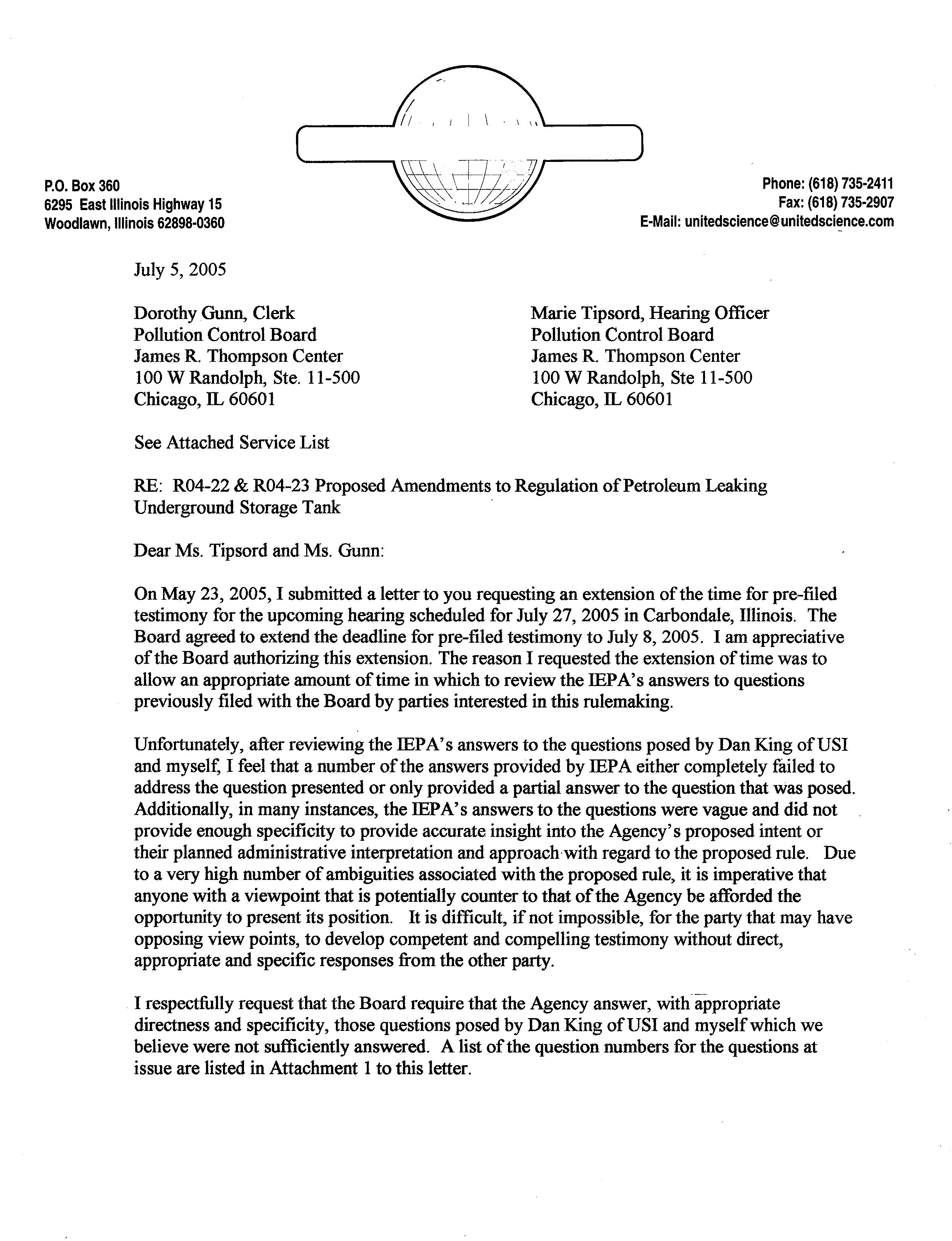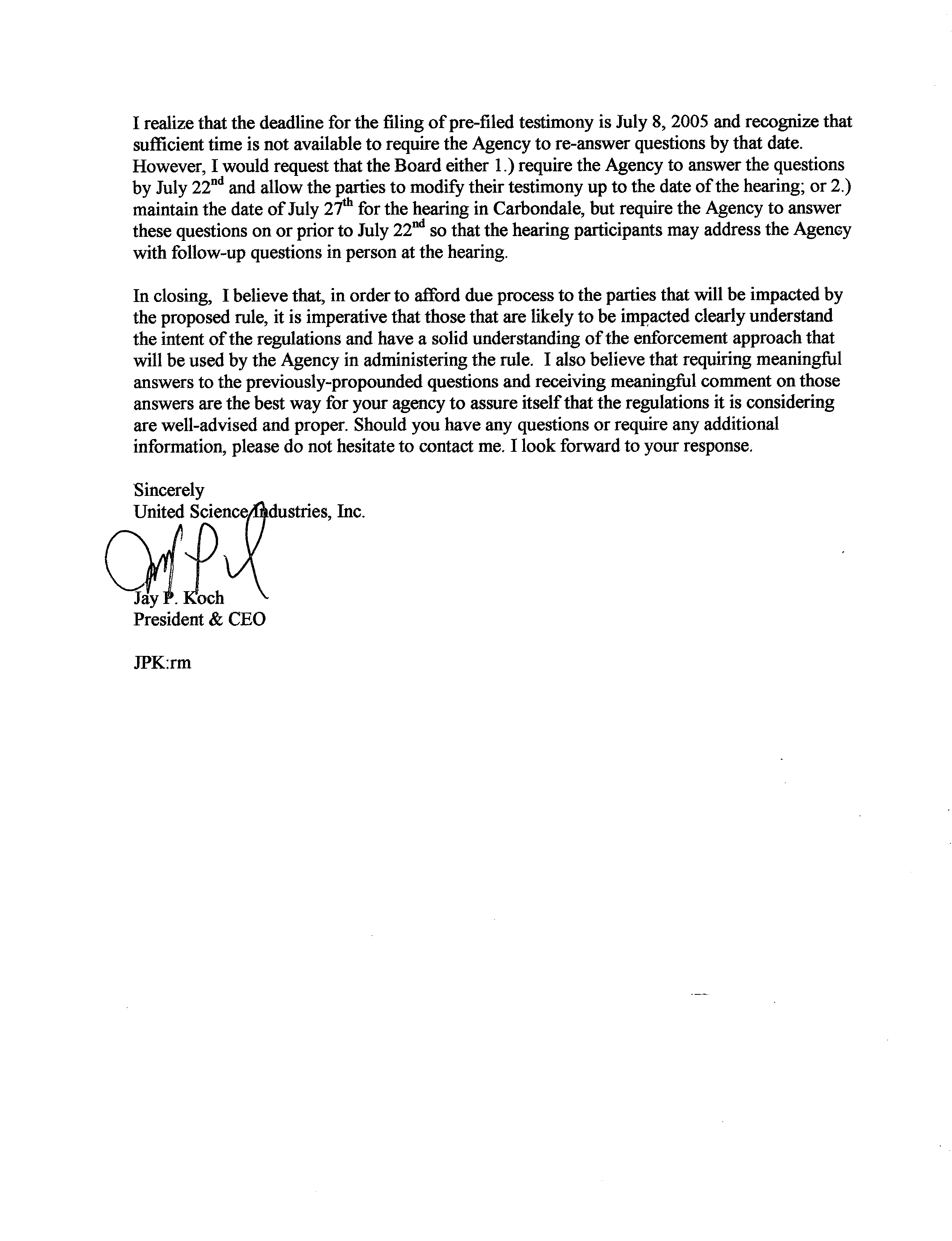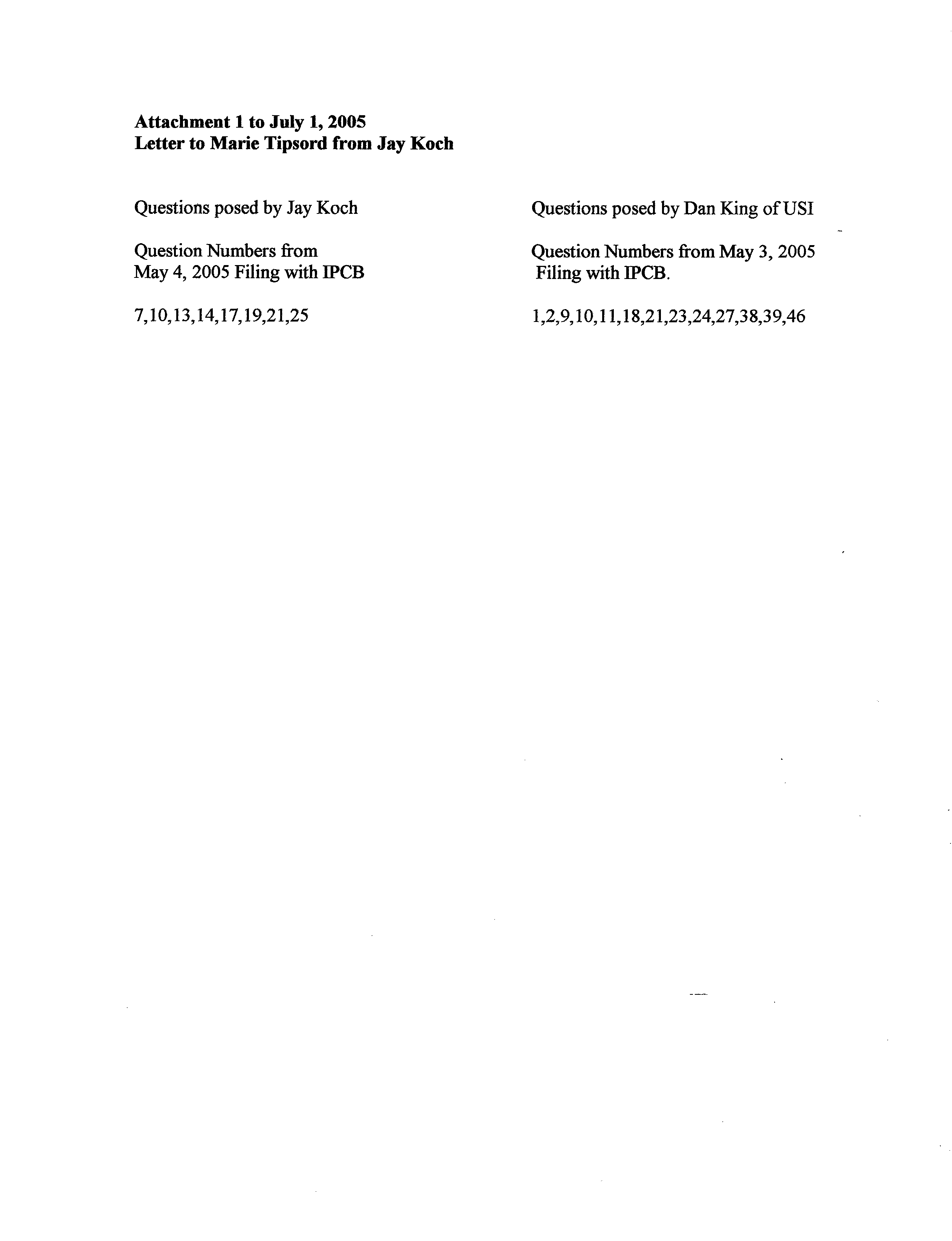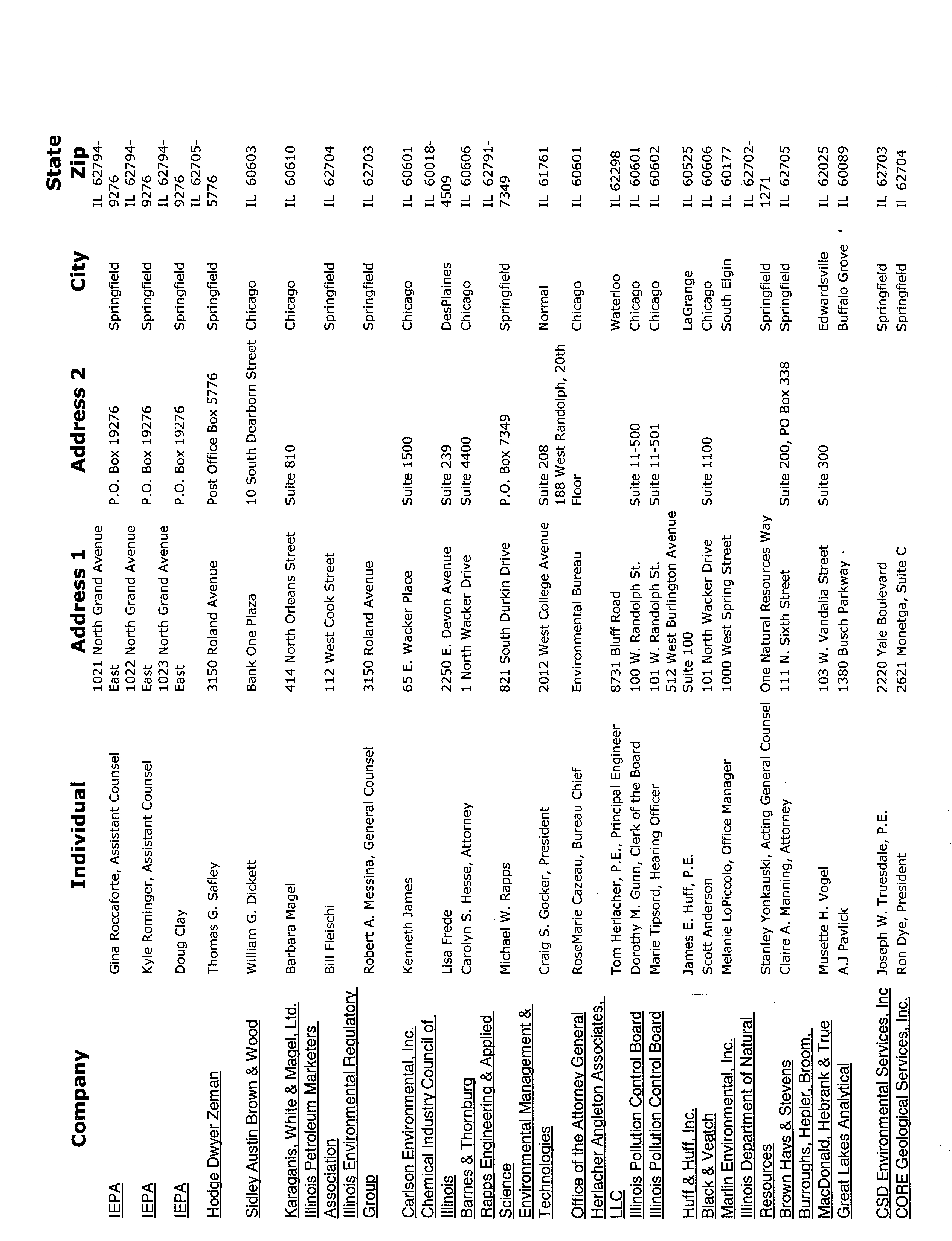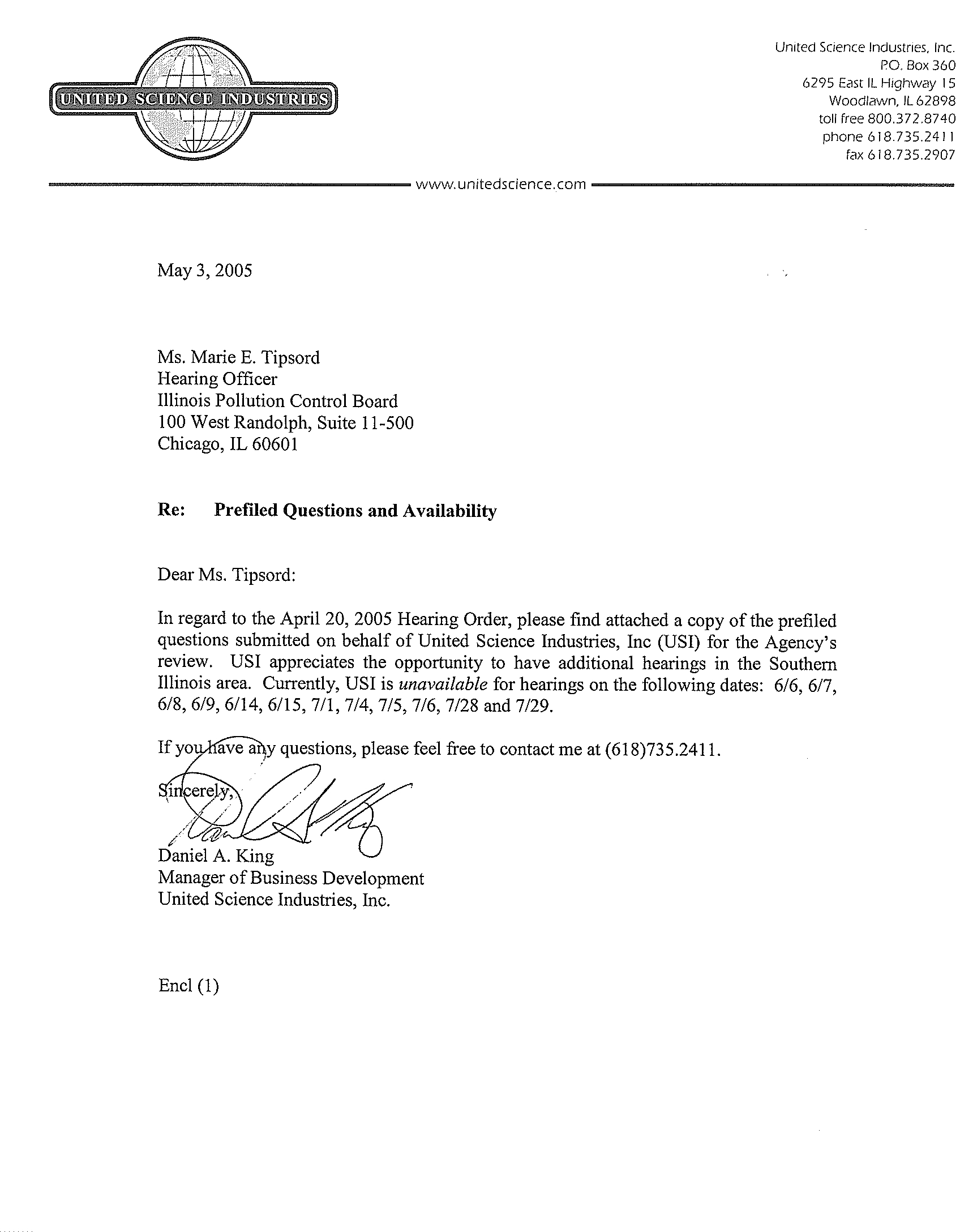ELECTRONIC FILING, RECEIVED, CLERK'S OFFICE JULY 6, 2005
PC #46
ELECTRONIC FILING, RECEIVED, CLERK'S OFFICE JULY 6, 2005
PC #46
ELECTRONIC FILING, RECEIVED, CLERK'S OFFICE JULY 6, 2005
PC #46
ELECTRONIC FILING, RECEIVED, CLERK'S OFFICE JULY 6, 2005
PC #46
ELECTRONIC FILING, RECEIVED, CLERK'S OFFICE JULY 6, 2005
PC #46
Questions:
(NOTE: All questions and regulations references have been asked relative to the
proposed 734 regulations, where applicable questions would also apply to corresponding
sections of 732 and possibly 731 regulations as well)
1. Pursuant to 734.210(a) there are activities that are required to be performed within
24 hrs of the confirmation of the release. Pursuant to 734.625(a)(1) Early Action
activities conducted pursuant to Subpart B are eligible for reimbursement.
However, Subpart H does not include a pay item inclusive of these tasks.
Does the Agency intend to revise Subpart H to include a pay item for the
completion of activities pursuant to 734.210(a)?
If the Agency does not intend to revise Subpart H to include a pay item for these
costs, with what current Subpart H pay item are these costs associated?
2. Pursuant to 734.210(b) there are six (6) activities that are required to be
performed within 20 days of the notification of the release to IEMA.
734.210(b)(1) Remove Petroleum to prevent further release
734.210(b)(2) Visually inspect Release and prevent further migration
734.210(b)(3) Monitor/mitigate fire, explosion, & vapor hazards
734.210(b)(4) Remedy hazards posed by excavated or exposed soils
734.210(b)(5) Measure for the presence of a release
734.210(b)(6) Determine the possible presence of free product
However, Subpart H does not include a pay item inclusive of these tasks.
Does the Agency intend to revise Subpart H to include a pay item for the
completion of activities pursuant to 734.210(b)?
If the Agency does not intend to revise Subpart H to include a pay item for these
costs, with what current Subpart H pay item are these costs associated?
3. Pursuant to 734.210(d) the owner/operator is required to prepare a 45-day report.
In the event of an Early Action extension (734.210(g)) is it necessary and required
to submit a 45-day report within 45+14 days from notification to IEMA if all
Early Action activities are not yet complete?
Doing so would require the submission of an amended 45-day report at the
conclusion of early action activities and potentially result in an unnecessary
duplicated effort.
5/3/2005
Page 1 of 10
ELECTRONIC FILING, RECEIVED, CLERK'S OFFICE JULY 6, 2005
PC #46
Does the early action extension provided for in 734.210(g) also extend the
submission deadline for the report that is required in 734.210(d) to the end of the
early action period?
If not, and two reports are required to be submitted under this circumstance,
would the preparation of the second 45-day report be considered an extenuating
circumstance and therefore reimbursable on a time and materials basis pursuant to
734.850?
4. Pursuant to 734.210(g) an owner/operator may request in writing that activities
continue beyond the 45+14 day period.
Are the costs associated with performing this activity eligible and reimbursable?
If yes, is this activity considered an extenuating circumstance and therefore
reimbursable on a time and materials basis pursuant to 734.850?
If not, what applicable Subpart H pay items would apply to performing this task?
5. Section 734.810 of Subpart H allows for reimbursement of tank removal and
abandonment costs, performed pursuant to 734.210(f), on a per UST basis based
on the relative size of the tank.
Is it the Agency’s intent that this cost would include the cost for abandonment
slurry?
6. Taking into consideration that a waiver of the removal requirements set forth by
the Office of the State Fire Marshall (OSFM) to allow abandonment-in-place may
only be granted when unusual situations, determined by OSFM, are present that
make it infeasible to remove the UST(s),and as such no typical situation exists,
should all tank abandonment activities be considered as extraordinary
circumstances?
7. Section 734.845(e) allows for reimbursement of costs associated with travel time,
per diem, mileage, transportation, vehicle charges, lodging and meals for
professional personnel. However, there is not a complimentary section within
Subpart H to allow for travel costs associated with field personnel.
Would the Agency consider adding a Subpart H Pay Item for field equipment
mobilization charges as an hourly rate, by the mile, or a mileage scale in addition
to a field equipment mobilization permitting item on a time and materials basis?
If the Agency does not intend to revise Subpart H to include a pay item for these
costs, with what current Subpart H pay items are these costs associated?
5/3/2005
Page 2 of 10
ELECTRONIC FILING, RECEIVED, CLERK'S OFFICE JULY 6, 2005
PC #46
8. Section 734.845(a)(1) allows $960.00 for professional services associated with
the preparation for abandonment or removal of USTs, however, professional
services are also required but not limited to the following;
Preparation for Early Action Soil Abatement
Preparation for a Drilling Event
Preparation for Implementation of Conventional Corrective Action
Preparation for Implementation of Alternative Technologies
Would the Agency consider the addition of $960.00 for preparation for an Early
Action soil abatement, preparation for a drilling event, preparation for
implementation of conventional corrective action, and preparation for
implementation of alternative technologies?
If the Agency does not intend to revise Subpart H to include a pay item for these
costs, with what current Subpart H pay item are these costs associated?
9. Pursuant to 734.845 costs associated with professional consulting services must
include project planning and oversight, field work, field oversight, travel, per
diem, mileage, transportation, vehicle charges, lodging, meals, and the
preparation, review, certification, and submission of all plans, budgets, reports,
and applications for payment, and other documentation. Sections 734.845(a-f)
include provisions for each of the above mentioned, with the exception of costs
associated with applications for payment pursuant to 734.625(a)(14)
Does the Agency intend to revise Subpart H to include a pay item for the
owner/operator’s reimbursement of the costs associated with the preparation,
certification, and submission of a payment application for the following?
Early Action?
Site Investigation Stage 1?
Site Investigation Stage 2?
Site Investigation Stage 3?
Corrective Action?
If the Agency does not intend to revise Subpart H to include a pay item for these
costs, with what current Subpart H pay item are these costs associated?
10. In accordance with section 734.845(a)(2)(A-C) owner/operators may be
reimbursed for professional oversight of field activities when one or more of the
following circumstances is taking place:
removal/abandonment of UST’s,
ETD&B of contaminated backfill, soil sampling around abandoned UST’s, and
when a UST line release is repaired.
5/3/2005
Page 3 of 10
ELECTRONIC FILING, RECEIVED, CLERK'S OFFICE JULY 6, 2005
PC #46
This allowance does not account for professional supervision for the confirmation
of the release, the immediate actions taken to prevent any further release, and the
identification and mitigation of fire, explosion and vapor hazards.
Would the Agency entertain the addition of language to section 734.845(a)(2)(B)
which would allow for the reimbursement of professional oversight of these
activities on a time and materials basis pursuant to 734.850?
11. Pursuant to section 734.605(b)(3), an Eligibility & Deductibility letter is required
to complete an “application for payment”. Pursuant to 734.625(a)(15) the costs
associated with obtaining an Eligibility & Deductibility letter are considered to be
eligible and reimbursable. However, Subpart H does not include a pay item
inclusive of this task.
Does the Agency intend to revise Subpart H to include a pay item for the
preparation and submission of an Eligibility & Deductibility letter?
If the Agency does not intend to revise Subpart H to include a pay item for these
costs, with what current Subpart H pay item are these costs associated?
12. Pursuant to 734.345(b), an owner/operator as a minimum requirement must
conduct “best efforts” to obtain off-site access in accordance with 734.350.
However, Subpart H does not include a pay item inclusive of this task.
Does the Agency intend to revise Subpart H to include a pay item for conducting
“best efforts” to obtain off-site access?
If the Agency does not intend to revise Subpart H to include a pay item for these
costs, with what current Subpart H pay item are these costs associated?
13. Pursuant to 734.210(f) the owner/operator may, as a part of early action, perform
ex-situ treatment of contaminated fill material.
Will the owner/operator be
reimbursed for these activities in accordance with 734.850, on a time and
materials basis?
14. What technologies does the Agency consider “conventional” for the ex-situ
treatment of contaminated fill material?
15. In our experience, UST removal rates vary depending upon the equipment
required to remove said UST. For instance, tanks from 110-2000 gallons may be
removed with a backhoe, however, tanks with capacities from 2,001 - 10,000
gallons require a larger piece of equipment, such as an excavator, to be removed.
Any tanks larger than 10,000 gallons must be removed with a crane. Each of these
graduations increase the cost for the required personnel and equipment to carry
out the removal.
5/3/2005
Page 4 of 10
ELECTRONIC FILING, RECEIVED, CLERK'S OFFICE JULY 6, 2005
PC #46
Would the Agency be willing to restructure the UST volume pay item schedule to
account for these equipment limitations?
16. The titles listed within 734.APPENDIX E do not include a job description for the
personnel.
When performing a task where payment will be in accordance with Appendix E,
will reimbursement be based solely on the educational degree and experience of
the person performing the task, regardless of the task performed, the efficiency of
completing the task, and/or the success of regulatory compliance achieved by the
owner/operator by performing the task?
If not, would the Agency consider adding a section which would briefly describe
the tasks to be performed by each of the personnel listed in Appendix E?
17. Pursuant to Section 734.340(d) remote monitoring may be required during an
alternative technology.
How will costs associated with Agency required remote monitoring be
reimbursed?
18. In accordance with section 734.315(a)(2)(E) a hydraulic conductivity test must be
completed during Stage 1 Site Investigation activities. However, Subpart H does
not include a pay item for costs associated with performing and analyzing a
hydraulic conductivity test.
Does the Agency intend to revise Subpart H to include a pay item for costs
associated with performing and analyzing a hydraulic conductivity test?
If the Agency does not intend to revise Subpart H to include a pay item for these
costs, with what current Subpart H pay item are these costs associated?
19. Pursuant to 734.315(a)(3) an initial water supply well survey must be conducted
in accordance with 734.445(a). Currently 734.845(b)(7) of Subpart H provides
for the reimbursement of costs associated with water supply well surveys
conducted pursuant to 734.445(b & c). However, there is no Subpart H pay item
associated with activities conducted in accordance with 734.445(a).
Does the Agency intend to revise Subpart H to include a pay item for costs
associated with conducting an initial water supply well survey?
If the Agency does not intend to revise Subpart H to include a pay item for these
costs, with what current Subpart H pay item are these costs associated?
20. In accordance with section 734.845(b)(7), a lump sum rate of $160 will be
allotted for potable water well surveys which must be conducted pursuant to
5/3/2005
Page 5 of 10
ELECTRONIC FILING, RECEIVED, CLERK'S OFFICE JULY 6, 2005
PC #46
sections 734.445(b) or (c). The external costs associated with completing a
typical well survey are approximately $100 for ISGS and ISWS provided
information. Given this typical situation, labor costs associated with this task
would amount to $60.
Does the Agency feel that $60 is sufficient for the professional labor to comply
with the requirements set forth in section 734.445?
Is it also expected that this amount would account for time allotted for the
Professional Engineer’s review and certification, as required by 734.445(d)(4)?
21. Pursuant to 734.825(a)(1), for the purposes of reimbursement, the volume of soil
removed and disposed of must be determined by the dimensions of the excavation
plus 5%.
Will a site map with a cross section showing varying depths be sufficient to verify
this volume?
If yes, will it continue to be necessary to provide the following to the Agency:
a. Copies of the weight tickets from the landfill accepting the waste?
b. Copies of the special waste manifest?
c. Copies of the landfill invoice (provided that the landfill acted as a
subcontractor to the primary contractor)?
Would the additional cost of collecting GPS coordinates to determine the volume
of the excavated material be considered reimbursable on a time and materials
basis pursuant to section 734.850?
22. It is USI’s experience that offsite investigations often require widely varying and
unknown scopes of work.
Would the Agency consider revising the Subpart H pay item associated with
preparation and submittal of a Site Investigation Completion Report pursuant to
734.845(b)(8) to T&M if completed during Stage III due the variability and
inconsistencies within this stage of work?
23. Pursuant to 734.320(b)(3)(A) the owner/operator is required to include within
their Stage 2 Site Investigation Plan one or more maps detailing hydraulic
gradient and groundwater flow direction. In order to obtain this information, an
additional site visit, apart from the installation of groundwater monitoring wells,
is required to collect the necessary data.
Does the Agency intend to revise Subpart H to include a pay item for costs
associated with completing a survey of groundwater flow direction and gradient?
5/3/2005
Page 6 of 10
ELECTRONIC FILING, RECEIVED, CLERK'S OFFICE JULY 6, 2005
PC #46
If the Agency does not intend to revise Subpart H to include a pay item for these
costs, with what current Subpart H pay item are these costs associated?
24. In addition to the half-day for each monitoring well drilled in accordance with
section 734.845(b)(2)(B) and 734.845(b)(6)(B), would the Agency entertain the
addition of one (1) additional half-day for each required trip to the site including:
well development, well surveying, and well sampling?
25. It is mentioned within the Illinois Pollution Control Board’s “Discussion” notes,
page 80, that section 734.845(b)(5) and (6) will be deleted from the regulations
and that the language “payment for costs associated with Stage 3 site
investigations will be reimbursed pursuant to Section 734.850” will be added in
its place, however, this language has not been included in the Board’s proposed
section 734.845 (b).
Is this omission an error?
26. In Brian Bauer’s Prefiled Testimony submitted March 5, 2004, Mr. Bauer
indicates that “neither incidental expenses nor decontamination charges” were
necessary, thus the rate for direct push injections is substantially lower than direct
push soil borings ($15/ft vs. $18/ft). Based on our experience, costs associated
with expendable items will not change drastically between investigation and
injection activities. Although investigation activities utilize expendable materials
used only for sample collection, injection activities utilize expendable points to
prevent soil from clogging the injection rod. As a result, the cost differential
between these two activities is insignificant. Additionally, decontamination
between injection points is still necessary to prevent cross contamination.
Would the Agency be willing to increase the per foot rate for Direct Push
injections listed in 734.820(a) to $18.00/foot.
27. Is the cost for the placement of an engineered barrier pursuant to 742.1105
eligible for reimbursement? For the purposes of reimbursement, is it required that
the design of said barrier be approved by the Agency prior to implementation? If
yes, why then would the same proposed rates not apply for engineered barriers as
they do for replacement of surface materials?
28. It is our understanding that conventional groundwater remediation strategies
include the use of institutional controls.
What other groundwater remediation mechanisms are characterized as
“conventional” by the Agency? Subpart H does not include a pay item inclusive
of these tasks.
Does the Agency intend to revise Subpart H to include a pay item for the
completion of activities pursuant to 734.210(a)?
5/3/2005
Page 7 of 10
ELECTRONIC FILING, RECEIVED, CLERK'S OFFICE JULY 6, 2005
PC #46
If the Agency does not intend to revise Subpart H to include a pay item for these
costs, with what current Subpart H pay item are these costs associated?
29. Pursuant to 734.340 an owner/operator may choose to use an alternative
technology for corrective action in response to a release.
In the event the cleanup strategy utilizes both conventional and alternative
remedial methods, and the owner/operator elects to submit a single corrective
action plan (CAP) inclusive of both technologies, will the costs associated with
the preparation and submission of the CAP be reimbursed pursuant to 734.850 on
a time and materials basis?
Or will the owner/operator be required to submit two (2) CAPs?
If two (2) CAPs must be submitted, will the Agency consider the cost for the
conventional technology CAP reimbursable pursuant to 734.845(c)(1) and
consider the cost for the alternative technology CAP reimbursable pursuant to
734.850?
30. It is USI’s experience that an Agency project manager may request a groundwater
remediation CAP be proposed after soil remediation has been completed. Would
the submission of two (2) separate CAPs be reimbursed pursuant to 734.845(c)(1)
for each submittal independently?
31. In accordance with 734.355(c) any action by the Agency to require a revised CAP
pursuant to 734.355(b) must be subject to appeal to the board with 35 days after
the Agency’s final action.
Should 734.355(c) be revised to include budgets as well as plans?
32. The competitive bidding requirements provided in 734.855 provide an alternative
means for establishing the maximum payment amounts. One of the requirements
of 734.855 (a) is that any bid solicited under 734.855 be based upon the same
scope of work as the applicable Subpart H maximum payment amounts. Since the
scopes of work have not been defined as part of Subpart H, maximum payment
amounts, how are the owners/operators to use 734.855 as a reasonable alternative
to determine maximum payment amounts?
33. Section 734.860 provides that the Agency may reimburse an amount in excess of
Subpart H, maximum payment amounts, if an owner or operator incurs or will
incur eligible costs that exceed the maximum payment amounts set forth in
Subpart H. Since no scope of work is defined in relation to Subpart H, maximum
payment amounts, is an owner/operator to assume that all costs incurred in
response to a release above the maximum payment amount are extraordinary or
unusual in the definition of eligible under 734.675?
5/3/2005
Page 8 of 10
ELECTRONIC FILING, RECEIVED, CLERK'S OFFICE JULY 6, 2005
PC #46
34. How will the Agency determine prevailing market rates pursuant to 734.875?
35. How does the Agency intend to collect the data needed to require with 734.875?
36. Would the Agency consider adjusting the maximum payment amounts on January
1 of each year instead of July 1 of each year so that it would be more consistent
with the fiscal year most often utilized by private businesses (owners/operators
and consultants)?
37. If the inflation factor in a given year is greater than 5.0% the adjustment in the
maximum payment amount under 734.870 would be limited to 5.0%.
Why not adjust by the increase in the CPI since it is reflective of actual market
conditions?
38. When engineering a remedial strategy for an active station, conventional
technologies are often not applicable (ex. a dig and haul is not possible when a
live system is in place), therefore one must look to alternative remedial designs.
In reference to Section 734.340(b), an owner/operator must submit a budget that
demonstrates that the cost for said alternative technology will not exceed the cost
of conventional technologies.
Is it the Agency’s intent to hold an owner/operator liable for costs in excess of the
conventional technology amount when a conventional technology is not feasible?
Would this circumstance be considered extraordinary?
39. Pursuant to section 734.340(c) what is the Agency’s intent in rendering an owner/
operator “ineligible to seek payment for the subsequent performance of a
corrective action using conventional technology” when prior approval for
implementing an alternative technology is not first attained?
Would the owner/operator be considered ineligible to seek payment for the
subsequent performance of an alternative technology as well?
40. Pursuant to section 734.320(b)(3)(A-D) and 734.325(b)(2)(A-D) an
owner/operator is required to produce one (1) or more maps, however, no limit is
placed on the number of maps which may be required. Is it assumed that map
preparation costs are to be included within the primary reporting lump sum task
for each phase (ex. EA-$4800, SI-$1600/$3200, CA-$5120)?
If so, how can a lump sum amount be determined if the scope of work (one (1) or
more maps) cannot be determined?
41. Pursuant to 734.835 Sample Handling and Analysis, costs associated with
transportation, delivery, preparation, analysis and reporting of samples are
5/3/2005
Page 9 of 10
ELECTRONIC FILING, RECEIVED, CLERK'S OFFICE JULY 6, 2005
PC #46
reimbursable costs and should be billed in accordance with the rates listed in
734.APPENDIX D. Is it the Agency’s intent that the per sample rates listed may
be divided up between the entity doing the transportation, deliver, analysis, etc.?
42. When determining acceptable depths for well installation activities, what entity,
Agency or consultant, decides what depth is sufficient?
43. Are Subpart H unit rate reimbursable amounts billable within all applicable
phases of work?
44. Pursuant to 734.315 Stage 1 Site Investigation, 734.320 Stage 2 Site
Investigation, and 734.325 Stage 3 Site Investigation, an owner/operator may be
required to advance soil borings in an attempt to fully delineate soil contamination
present on-site. As a result, what constitutes a “soil boring”? i.e. are minimum
depths required or must specific tooling be utilized?
45. Pursuant to 734.815 Free Product or Groundwater Removal and Disposal and
734.830 Drum Disposal, an owner/operator may be reimbursed for costs
associated with disposal of petroleum contaminated soil and/or groundwater as a
result of drilling activities. Who determines, however, whether media should
drummed or disposed of in bulk?
46. Pursuant to 734.845 Professional Consulting Services, how many submittals are
included in each unit rate reporting pay item?
47. Have all rates associated with Subpart H pay items been historically evaluated
against actual reimbursement submittals?
5/3/2005
Page 10 of 10
ELECTRONIC FILING, RECEIVED, CLERK'S OFFICE JULY 6, 2005
PC #46
RECEIVED
CLERK’S OFFICE
MAY 042005
STATE OF ILLINOIS
May
4, 2005
Pollution Control Board
Ms. Marie Tipsord
Hearing Officer
Illinois Pollution Control Board
James R. Thompson Center
100 West Randolph, Suite 11-500
Chicago, Illinois 60601
Re: Questions and Additional Hearing(s) pertaining to R04-22 (UST Rulemaking) &
R04-23 (UST Rulemaking Consolidated)
Dear Ms. Tipsord:
First, let me thank the Board for determining that at least one additional hearing
shall be held in the above referenced matter. Also, thank you for considering and
acknowledging the request of the many Southern Illinois-based employees ofEcoDigital
Development Group and United Science kdustries, Inc.
Although by regional and national standards United Science Industries, Inc. is a
very small firm, in the economy of the Southern Illinois region, our company is a
significant employer. Our employees, many ofwhich are native to Southern Illinois and
desire to remain close to their roots, are appreciative of their employment and are
concerned about the potential implications of this rule on their employment and our
industry.
As members ofthe largest LUST services firm in the entire State ofIllinois, USI’s
employees represent a client base from Chicago to Cairo, from the Indiana state line to
the Mississippi River. USI’ s employees serve a client base which is the largest in the
UST business in the State of Illinois by a factor of nearly two to our nearest competitor.
USI’ s client’s consists of owners/operators from numerous socioeconomic sectors
ranging from highly profitable well-capitalized businesses to undercapitalized small
businesses and even the financially destitute. Having been in the industry in Illinois since
its inception, and having the practical experience of working on hundreds ofLUST sites
across all regions of the state for numerous owners/operators with varying social,
economic and ethnic backgrounds, USI and its employees have an immense knowledge
base regarding the needs and concerns of the UST owner/operator. As advocates of our
clients (especially the mom & pop operator), our employees want to share their collective
knowledge base with the IPCB to ensure that the record in this rulemaking reflects this
vast base of knowledge and practical experience and most importantly the needs and
desires ofour clients.
Page 1 of3
ELECTRONIC FILING, RECEIVED, CLERK'S OFFICE JULY 6, 2005
PC #46
Again, thank you for hearing each ofUSI’s employee’s individual requests. Their
livelihood, and those ofthe hundreds ofIllinois’ owners/operators that USI represents are
all dependent upon the long term viability of the Illinois LUST program. As a result, we
are fully in support ofthe implementation of a fair cost containment rule that assures the
viability of the LUST program for many years to come. Therefore, it is highly important
to all ofus that the rules that are eventually adopted pursuant to this rulemaking be based
upon accurate, reliable and relevant facts and that the rule that is crafted be able to be
administered fairly, objectively, uniformly and transparently. It is with these goals in
mind that USI and its employees desire to participate in this process.
In one of the recent postings to your website, you requested that interested parties
provide you with dates in June and July during which their time had already been
scheduled so that you could consider the commitments of the various parties when
contemplating dates for the upcoming
-
hearing.
I have previously scheduled
commitments for the entire time period from June
1st
through June
26th~
I am available
from June 27th through the end of July.
In any case, I am committed to providing
constructive input and suggestions during the remainder of this rulemaking and am
willing to make sacrifices in my schedule to facilitate participation in the hearings if the
proposed hearing date conflicts with my schedule. The employees of USI that desire to
participate in the rulemaking will provide you with their schedules under separate cover.
The Board also recently requested that written questions be presented by May 4,
2005. The Board also made notice that the questions posed would be answered by May
18, 2005. I assume that questions may be posed to either the Board or the Agency and
will be answered accordingly.
I also assume that, after all interested parties have
received the answers to the questions posed pursuant to the May 4th dead-line, the Board
will request pre-filed testimony for this summer hearing(s) thereby allowing the
testimony of the participants to consider the Board’s and Agency’s responses to the
questions. Therefore, although I hope to have an opportunity to testify at this summer’s
hearing and provide the board with a con~siderableamount of information that I believe
needs to be on the record before a final rule is promulgated, under cover of this letter I
am simply providing the questions requested of the participants by May 4th
You will note that many of the questions that I am submitting have the goal of
attempting to objectively define how the Agency intends to interpret and administer these
rules with regard to professional service tasks. It is my belief, and I believe that ofUSI’s
employees and our colleagues in the industry, that the largest area of discrepancy
remaining in this rulemaking is the fact that, as a practical matter, these rules if
interpreted and administrated in an absolute sense by the Agency, will simply not allow
enough time for the environmental professional to complete the professional service tasks
required under the Act as historically enforced by the Agency.
This is very problematic as the result could be hundreds of appeals and
unnecessary costs to all involved parties. Hopefully, the question and answer period
proposed by the IPCB will resolve many of these issues and the remainder can be
Page 2 of3
ELECTRONIC FILING, RECEIVED, CLERK'S OFFICE JULY 6, 2005
PC #46
resolved at the upcoming hearing(s). My questions are attached.
Other questions are
being submitted separately by other employees of United Science Industries, Inc.
Sincerely,
United Scien4~ndustries,Inc.
Jay P. Koch
President
Page3of3
ELECTRONIC FILING, RECEIVED, CLERK'S OFFICE JULY 6, 2005
PC #46
RECEIVED
CLERK’S OFFICE
BEFORE
THE ILLINOIS POLLUTION CONTROL BOARD
MAY
042005
IN THE MATTER OF:
)
STATE OF
ILLINOIS
)
R04-22
Pollution Control Board
PROPOSED AMENDMENTS TO:
)
(IJST Rulemaking)
REGULATION OF PETROLEUM LEAKING
)
UNDERGROUND STORAGE TANKS
35
)
ILL. ADM. CODE 732
)
IN THE MATTER OF
)
)
R04-23
REGULATION OF PETROLEUM LEAKING
)
(UST Rulemaking
UNDERGROUND STORAGE TANKS
)
Consolidated)
PROPOSED NEW IlL. ADM. CODE 734
)
Proposed Rule. First Notice
PRE-FILED QUESTIONS FROM Jay P. Koch FOR THE ILLINOIS POLLUTION
CONTROL BOARD’S
1St
NOTICE OF AMENDMENT TO 35 ILL. ADM. CODE 734
AND 35 ILL. ADM. CODE 732.
-
Below are questions proposed by Jay P. Koch in response to the Illinois Pollution Control
Board’s request for pre-filed questions. These questions are presented in order to gain a
better understanding ofthe Agency’s intent and approach to the implementation and
administration ofthe proposed rules and the UST program subsequent thereto in order to
facilitate the preparation and development ofaccurate, factual and meaningful testimony
for the hearing(s) to be held this summer in the above referenced matters.
Questions:
1. In Mr. Clay’s testimony, he stated that groundwater remediation is, by definition,
considered to be an alternative technology. Some, but not all, IEPAtechnical reviewers
require that a Corrective Action Plan, in order to be acceptable, address both soil and
groundwater remediation. In a situation where the owner/operator is proposing a
corrective action to the agency for both soil and groundwater remediation and assuming
that the proposed method ofsoil remediation would be excavation, transportation and
disposal, how would the Agency administer the Subpart H maximum payment amounts?
Would this be treated as a conventional cap (maximum lump sum payment amount) or an
alternative technology CAP (Time & Materials) or would it be a hybrid?
2. Several consultants have recently mentioned that it is very difficult to have alternative
technology CAPS (for soil remediation) approved by the Agency. If an alternative
Page 1 of7
ELECTRONIC FILING, RECEIVED, CLERK'S OFFICE JULY 6, 2005
PC #46
technology CAP is submitted to the Agency and it is not approved, how does the Agency
intend to deal with associated reimbursement issues under Subpart H? Specifically, if an
alternative technology CAP is rejected one or more times, but is eventually approved by
the Agency, will the Agency reimburse all professional service hours that are reasonable
and justified so long as the rates for professional services are consistent with Appendix
E? Ifthe alternative technology Corrective Action Plan was rejected by the Agency
reviewer on one or more occasions, and as a result the owner/operator elects to
subsequently submit a CAP for a conventional technology, will the costs associated with
the development ofthe alternative technology CAP be paid pursuant to Subpart H on a
time and materials basis with the costs ofthe subsequently prepared conventional
technology CAP being reimbursed on a maximum lump sum payment basis in
accordance with
734.845
(c) (1)?
3. How does the Agency intend to administer the “extraordinary circumstances”
provision? In order to avoid the landslide o~’questionsand conflicts that are almost
certain to arise afterthe implementation ofany rule changes ofthe magnitude represented
by Subpart H, is the Agency, prior to the final implementation ofthe rule, willing to
publish on a regulation by regulation basis, examples ofthe types of situations that it
believes will warrant a claim for “extraordinary circumstances”?
4. Market research and analysis performed by USI indicates that nearly ninety-five
percent ofthe owners/operators that are currently engaged in LUST clean-ups in Illinois
are individuals or very small businesses. Many ofthese individuals and small businesses
do not belong to the organizations that are listed as being the parties that will appoint the
Members ofthe LUST Advisory Committee. Will the IEPA consider allowing an
additional seat or seats on the LUST Advisory Committee in order to assure the
representation ofthis category ofowner/operator?
5.
The Agency is proposing revisions that would allow the Agency to remotely monitor
alternative technologies? Is reimbursement for these activities to be handled on a time
and material basis?
-
6. Subpart H, Appendix D provides rates for Sample Handling and Analysis. Section
734.83
5
indicates that these rates are fortransportation, delivery, preparation, analysis
and result reporting. Often times analytical samples are transported to a central shipping
location by one party, delivered to the laboratory by another and then analyzed by the lab
(a third party). Are the rates provided in Appendix D to cover the activities of all three
parties described above?
7. In numerous instances in the Agency’s testimony, the Agency testified that the
proposed rules were being presented in order to “reform the budget and reimbursement
process” and to “streamline the approval ofbudgets and the processing ofreimbursement
claims”. An additional goal stated by the Agency was to “streamline the UST
remediation process”. Does this mean that the Agency’s intentions are to improve upon
(reduce to the greatest extent practicable) the amount oftime that it takes for the various
reviews, approvals and/or reimbursements?
Page2of7
ELECTRONIC FILING, RECEIVED, CLERK'S OFFICE JULY 6, 2005
PC #46
8. The Agency testified that the rates are generally consistent with the rates the Agency
currently approves. The Board accepted the Agency’s position on this matter as part of
the rule that was published at
1st
notice. The consulting community, on the other hand,
believes that the rates that are provided in the proposed regulations are not consistent
with those that have historically been reimbursed. Instead the consulting community is
confident that the amount oftime that hasbeen allowed for various professional service
tasks and by extension the maximum lump sum payment amounts are substantially below
those which have been historically reimbursed by the Agency. This has been a
significant point ofcontention during this rulemaking and represents a conundrum. A
simple answer to this conundrumwould be to have a qualified and reputable independent
third party audit the historical reimbursement records ofthe Agency with regard to the
average costs forprofessional services per hour as well as the average number of
professional service hours incurred per labor classification per task and to allow the audit
report to be published, available to the public and placed on the record in this rulemaking.
Is the Agency willing to allow an independent auditor to perform a statistically valid
review ofthe Agency’s historical files and to provide the results ofthat audit to be
entered into the record in this proceeding?
9. The Board has acknowledged that the method that the Agency used to establish the
rates provided in Subpart H was not based upon scientific or statistically valid means.
The Board has further acknowledged that it is largely relying upon the experience ofthe
Agency and that the Board finds the rates proposedby the Agency in Subpart H to be
reasonable. I would generally agree with the Board’s assessment and opinion with the
exception that I believe that the numberofhours that have been allotted for professional
and consulting service tasks that are subject to the maximum lump sum payment amounts
and therefore, by extension the maximum lump sum payment amounts themselves are
substantially inaccurate, for those services the rates that have been established for
professional services and consulting. It appears that the number ofhours that the
Agency has allotted to professional service tasks is woefully inadequate.
Since the
Board has acknowledged that the Agency did not use statistically valid means to establish
the rates, what independent validation steps has the Board taken, or does it plan to take,
in order to assure that the number ofhours that the Agency has allotted for professional
and consulting services is sufficient to allow a reasonably proficient professional to
complete each ofthe necessary tasks?
10. Can the Agency please provide a list ofthe governmental fees and permits that it is
considering not being eligible for reimbursement? Can the Agency provide a list of
examples ofthe types ofpayments to other persons that it considers to be ineligible for
reimbursement?
11. Because this rulemaking is likely to be the most momentous in the history ofthe
Illinois LUST program and is likely to have a profound financial impact on numerous
owners/operators and consultants across the State ofIllinois, is the Board willing to make
a second request for the Illinois Department ofCommerce and Community Affairs to
perform an economic impact study ofthese proposed regulations? It is my understanding
Page 3 of7
ELECTRONIC FILING, RECEIVED, CLERK'S OFFICE JULY 6, 2005
PC #46
that, when requested to do so last year, the DCEO declined to provide this assessment for
budgetaryreasons.
12. In their 2004 testimony, the Agency indicated that 375 consultants performed work
on LUST Sites in the last three years. Can the Agency provide a list ofthe names ofthe
consulting firms that, in the aggregate, submitted fifty percent
(50%)
ofthe work plans,
budgets and reports to the Agency from the period January 2003 to the present?
13. The Agency objected to the notion ofproviding a “Defined Scope ofWork” for the
Subpart H payment items. The Board, at first notice, agreed with the Agency’s position
on this matter. On page 78, the BOard seems to suggest that the consulting community
wanted a defined scope ofwork to be separately developed for each project and also
suggest that such a requirement would result in a highly cumbersome rule. I agree with
the Board in that regard. As a point ofclarification it has not been USI’s desire that a
detailed scope of work be prepared for each project. Rather, USI would like some
definition to be set forth, on a task by task or regulation by regulation basis, that will help
everyone understand what is to be considered “typical” and what is to be considered
“extraordinary”. Would the Agency consider publishing, in advance ofthe effective date
ofthis rule, some broad guidelines as to what is “typically required” on a task by task or
regulation by regulation basis?
14. Is it the Agency’s intention that upon satisfaction ofthe deductible, and provided
that the limitations on total payments provided for in 734.620 have not been exceeded,
that the LUST Fund reimburse all corrective action costs that are eligible under 734.
625?
15.
Iffunds are not available under the LUST Fund program, or as a result ofthe
implementation ofSubpart H, the Agency is unable to pay for all ofthe eligible @ursuant
to 734.625) corrective action costs incurred by an owner/operator in excess ofthe
deductible, does this in any way relieve the owner/operator ofthe responsibility to
comply with IEPA regulations and remediate the site?
16. Ifthe answer to the above question is “no” then, does the Agency intend to enforce
the Act and the LUST regulations, including the levying of fines and penalties, against
owners/operators that are unable to comply?
17. A practice, which has become common in the industry in Illinois, and which is
necessitated by long reimbursement cycles, is for consultants and/or contractors to
perform corrective action work forthe owner/operator and to generally wait forpayment
for their services until such time that the owner/operator has been reimbursed by the
LUST Fund. What is the Agency’s opinion on consultants/contractors deferring payment
for their services in excess ofthe deductible until such time that the owner/operator is
reimbursed? What is the IPCB’s opinion on this issue? Do the Agency and the Board
believe that the proposed regulations, or any portion thereofhave any bearing on this
practice on the part ofthe consultant’s/contractors?
Page 4 of7
ELECTRONIC FILING, RECEIVED, CLERK'S OFFICE JULY 6, 2005
PC #46
18. In the late 1980’s and the early 1990’s the Agency administered a Joint Payment
Program whereby the Agency would make joint reimbursement payments to the
Owner/Operator and their primary consultant/contractor. Why did the Agency do away
with this program?
19. In Mr. Chappel’s testimony, he indicatedthat the activities conducted by a
consultant in each step ofthe LUST process and the estimated personnel time required
for each activity were provided to the Agency byACECI. Who, at ACECI or from other
organizations, participated in this process? What are their qualifications and credentials?
How much experience, do they have in Illinois LUST work and in what capacity? What
scope ofwork was given to them in order for them to determine what was required at
each step in the process? After receiving the estimated personnel titles and the estimated
number ofhours from ACECI did the Agency make any modifications or additions to the
information provided by ACECI before incorporating the information into the proposed
rule? Why in this instance did the Agency rely on a third party to estimate the
appropriate staffing and level ofeffort required instead ofusing information from its
historical experience? When was the information provided to the Agency by ACEd?
20. Is the Agency familiar with a USEPA initiative referred to as TRIAD?
21. Is it the Board or the Agency’s intention that personnel that do not meet the degree,
licensing or experience requirements ofAppendix E. but that have been previously
employed in their respective positions prior to the effective date ofthe rules, be
grandfathered into their current positions? In the alternative will these personnel be
disqualified from their positions and subject to layoff? Ifa person does not meet the
degree, licensing and experience requirements for the Project Manager labor category,
but can demonstrate that it has been able to successfully develop work plans and budgets,
gain Agency approval ofthose work plans and budgets and successfullymanage the
project with a high level ofreimbursement by the Agency, can is it the intent of Subpart
H and the Agency that this person will no longer be considered qualified to perform their
job and therefore be subject to potential layoff by their employer?
22. If a person does not strictly meet the degree, licensing or experience requirements of
Appendix E how would the Agency go about determining what T&M billing rate would
be applicable to the individual?
23. 734.850 indicates that the reimbursement ofpersonnel costs will be based upon the
work being performed and not the classification or title ofthe person performing the
work. Can the Agency provide a list ofthe classifications/titles that it considers to be
appropriate to the various tasks/regulations?
24. Does the Agency consider consulting/professional services to be subject to the
bidding requirements in Subpart H 734.855 as an alternative means ofestablishing the
maximum payment amount? I assume the bidding requirement only pertains to
contractors since the rule clearly delineates that consultants will be paid for bid
Page5of7
ELECTRONIC FILING, RECEIVED, CLERK'S OFFICE JULY 6, 2005
PC #46
solicitation preparation and bid review on a time and materials basis. Please clarify the
Agency’s intentions with regard to this matter.
25.
Ifthe answerto the question above is “yes” what scope ofwork should be used in the
bid solicitation since the scope ofwork associated with professional services is usually
unknown at the time that the owner/operator hires the consultant?
26. By what means is the owner/operator and his or her consultant required to solicit
bids? If a bid solicitation results in less than three bids, how many rounds of solicitation
are required?
27. As an example, an owner/operator has an approved budget for a corrective action to
excavate, transport and dispose of2,000 yards ofcontaminated soil. One evening during
the corrective action work it rains two inches and the excavation fills with water which
becomes contaminated when it comes into contact with soils in the excavation. The costs
of the water disposal was not in the budget. How would the Agency administer this type
of situation, assuming that the owner/operator makes a claim for reimbursement ofthe
water disposal costs from the LUST Fund?
28. As an example, an owner/operator hires a consultant to perform consulting and
professional oversight services at its LUST site. The consultant performs the work
required to obtain Agency approval ofa Corrective Action Plan for conventional
technology. The consultant bills the owner/operator for the service and the
owner/operator is reimbursed. The owner/operator pays the consultant. After the
completion ofthe excavation work stipulated in the approved CAP, the Agency reviewer
requests a groundwater remediation to be performed. How will Subpart H be applied to
this situation? Will the time necessary to develop the groundwater CAP be reimbursed on
a time and materials basis.
29. Tn calculating the maximum lump sum payment amounts for the various plans and
reports required as part of EarlyAction, Site Investigation and Corrective Action phases
of a project, did the Agency assume that the various plans and reports would be approved
by the Agency reviewer on the
1st
submission? I assume this is the case since $640 is
provided for Amended Plans and Amended Reports?
30. 734.845 (f) provides $640 forthe amendment ofa plan or report. It would appear
that this amount could be excessive in some instances and insufficient in other instances.
Because the degree ofmodification or amendment to a plan or report can vary widely, it
seems more appropriate and cost effective for the LUST Fund for this task to be
performed on a time and materials basis. Would the Agency consider the use of a T&M
billing method for the development ofamended plans and reports?
31. 734.800 (b) states that only some of the costs associated with each task are provided
in Section 734.8 10 through 734.850 and that they are not intended as an exclusive list of
all ofthe costs associated with each task for the purposes ofpayment from the Fund.
734.800 (c) goes on to state that Subpart H sets forth only the methods that can be used to
Page 6 of7
ELECTRONIC FILING, RECEIVED, CLERK'S OFFICE JULY 6, 2005
PC #46
--7
determine the maximum amounts that can be paid from the Fund for eligible corrective
action costs. The rules go on to state that whether a particular cost is eligible forpayment
must be determined in accordance with Subpart F. Ifa cost item that is typically
incurred on a LUST project has been accidentally omitted from Subpart H, how would
the owner/operator go about seeking reimbursement forthat costs?
32. Ifan owner/operator engages the services ofa professional consultant and the
consultant, in good faith, initiates the development ofa corrective action plan, only to
find out afterthe work was initiated and a substantial amount oftime, energy and money
had been expended that the project conditions warrant a level ofeffort that is likely to
cause its charges for the professional/consulting services to greatly exceed the maximum
payment amount provided in Subpart H. In this instance, does the Agency prefer to be
notified immediately ofthe potential “extraordinary circumstance”? It seems as though
all parties involved would want to know whether the Agency would consider the situation
to be extraordinary or not before continuing to proceed with the work. In the example
provided above, how should the owner/operator and his or her consultant handle this
situation with the Agency?
33. Does the Agency intend to develop internal standard operating procedures to help
improve and ensure uniformity, consistency and objectivity in its technical review of
work plans, budgets and reports?
34. The time to prepare and submit an application forreimbursement is an eligible cost
under 734.625 (a) (14). No maximum lump sum payment amount is provided forthese
activities. Will a maximum lump sum payment amount be provided for this activity?
35.
Under 734.445 (c
)
the Agency mayrequire additional investigation ofpotable water
supply wells. From reading this provision within the regulations, this requirement is
contingent and at the discretion ofthe individual Agency reviewer. Does the Agency
consider wells surveys conducted pursuant to this paragraph to be typical or
extraordinary?
36. Historically, the Agency has reimbursed on a time and materials basis the costs for
field instrumentation, equipment, materials and supplies (field purchases), materials and
supplies (stock items) and subcontractors related to professional and consulting services.
Subpart H provides Appendix D which deals with acceptable rates for sample handling,
transportation, delivery, analysis and reporting and Appendix B which provides personnel
titles, qualifications and acceptable hourly rates. However, Subpart H does not provide a
list of field instrumentation, equipment and materials and supplies that are acceptabld in
situations where the rules call fortime and materials billing. Will the Agency be
providing time and materials rates for field instrumentation, equipment and materials and
supplies that will be considered to be the maximum payment amounts for those items
when the work is associated with a time and materials task?
Page 7 of7
ELECTRONIC FILING, RECEIVED, CLERK'S OFFICE JULY 6, 2005
PC #46


